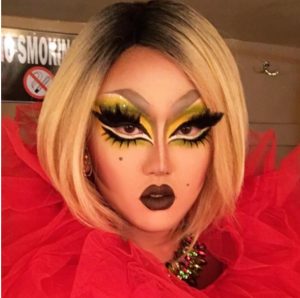Dina’s Diner 6/6/16
RACE FOR A CAUSE
The New York Times had a large article about RuPaul’s Drag Race television show in the May 16, 2016 Arts section. The piece was headlined, “A Bold Struggle for Acceptance” with a sub-heading saying the show’s 8th season “valued honesty, growth and exploration over hyper-femininity.”
I must confess that I don’t watch Ru’s show so I’ll have to take the article’s premise at face value. That premise being that the contestants on the show’s eighth season were more human and relatable than previous performers who promoted a more perfectly feminine appearance. The article points to a conversation between the trans activist contestant “Bob the Drag Queen” and small-town queen “Chi Chi DeVayne” in which the latter laments she cannot be more open in her community. “You can’t do it in Shreveport. They’ll blow your head off.”
The article points out that despite all the press attention and advancements that trans people seem to be achieving, there are still “gaping chasms” between the aspirational trends and the reality for most trans folks. RuPaul himself is quoted, “They talk so much about acceptance now today and it’s like yes, but trust me…it’s superficial. Things haven’t changed that much. You see it in politics right now. We’re still a very, very, very primitive culture.”
The Times reporter, Jenna Wortham, seems to follow the show and is happy to see some of this season’s queens display some feet-on-the-ground realness. The article cites contestant “Kim Chi,” a breakout Asian-American queen who is “charming and chubby, with a lisp [whose] most revealing moment came when he tearfully revealed that he has hidden his exquisite talents at makeup and costume design from his own mother for fear she will be repulsed by his love of drag.” Ms. Wortham writes, “At its best, drag exposes the charade of modern life. Personality, growth, the ability to evolve and survive were the traits the judges prioritized this season.”
Who knew all that high-falutin’ social commentary was going on during a reality show for drag queens? I guess you have to watch to glean it all.
BREAKING THE CODE
The New York Times Thursday Styles section had an article headlined, “The End of the Office Dress Code” in the May 26, 2016 edition. The article was prompted by an exhibit at New York’s Museum at the Fashion Institute of Technology titled “Uniformity.” The museum has a collection of uniforms catalogued from military, work, school and sports.
The curator of the show admitted that uniforms are an unusual choice for a fashion museum. “I was interested in the inherent dichotomy between uniforms and fashion because while they should be antithetical to one another they are also deeply interrelated. It’s ironic.”
The Times article uses that as an introduction point to mention some instances when uniforms or dress codes have come under fire recently. It cites a case in England where a female worker was sent home for not wearing heels with her work ensemble; a big bank’s 44 page dress code instruction that included acceptable shades of underwear color; and a quickly withdrawn Kansas legislator’s directive admonishing women to dress appropriately when testifying before committees. Needless to say, most of the dress code instructions are aimed at women rather than men.
The article says, “The slippery slope [of dress code abandonment] may have started as a gentle incline in the 1970s and become a bit steeper during the “casual Friday” movement of the 1990s. But today we are speeding down at breakneck pace, partly thanks to the hot-button conversation around gender equality and fluidity.” According to The Times, the New York Human Rights Commission last December announced workplace guidelines that expressly prohibits enforcing dress codes and grooming standards. An interesting point was made for today’s driven careerists: if we identify with our work to such a great degree nowadays, “shouldn’t we be able to be ourselves at work?”
I think most people would agree that there should be some measure of appropriate dress for certain places or functions. But the current state seems to leave it to the individual to decide. The Times article said, “One person’s ‘appropriate’ can easily be another person’s ‘disgraceful’ and words like ‘professional’ are so vague as to be almost meaningless.”
I wonder if — looking far, far ahead — the trend towards gender neutrality may one day erase any differentiation in dress for men and women. The term “unisex” may finally come to really mean something instead of just another periodically recurring fashion trend. And where will that leave the ancient art of crossdressing? Perhaps crossdressing will leave us then.
TRANSITION QUESTIONS
The New York Times Thursday Styles section had an article about trans celebrity GiGi Gorgeous in the April 14, 2016 edition. Gigi started out as Gregory and became a YouTube star (while still known as Gregory Gorgeous) as he published videos about makeup, hairstyles and personal news for what grew to be over a million viewers. The earliest videos I could find were from 7 years ago when he was approximately age 16, which makes him something of a pioneer in that medium.
In 2013, according to The Times article, Gregory came out as trans and somewhere along the line adopted the name GiGi in place of Gregory. Now, as a result of her Internet fame and contacts made in the fashion world, GiGi has become an arbiter of fashion and pop culture.
But this item wasn’t meant to be a biography of GiGi Gorgeous, gorgeous though she indeed is. Her Times profile made me think about the process of transition we are seeing all around us, either literally or via the media. By way of advance apologies in case I misspeak, I know very little about the transition process nor the personal struggles that lead individuals to make that leap.
I do know that as recently as 20 years ago, or even more recently, it was much more difficult for people who identified as transsexuals (a quaint term nowadays) to transition. Aside from the social and family trauma — caused in more than a little part by ignorance of the subject — there was something called the “real life test” in which most therapists required the individual to live as the other gender for a year before prescribing sexual reassignment surgery. I don’t know if that is still something that is recommended or not. I never hear it mentioned anymore. Of course, not all trans people are looking for SRS anymore — another rather recent point on the trans spectrum.
Maybe it is just because of the fast moving media today, but it seems that trans individuals diagnose themselves and move themselves along at their own pace. Even toddlers are now diagnosing themselves as trans with the parents seemingly just along for the ride. I don’t have any issue with this. It’s none of my business, really.
A couple of weeks ago, we read a rumor that Caitlyn Jenner was going to de-transition back to male mode. And all liberal-minded folks were scornful of the innuendo, as perhaps they should have been. But with all the transitioning that seems to be happening — especially by people who have their celebrity and fortune tied up in the fact that they are trans — perhaps we should be prepared for some of these “icons” to opt out when the E! channel, fashion designers, and the Internet gets bored with trans celebrities.
NIGHT FLOWERS GROW ON SIDEWALKS
The online magazine, Slate.com, had an article on its May 20, 2016 edition titled “The Outlandish, Otherworldly Costumes of London’s Night Flowers.” Night Flowers is the term that British photographer Damien Frost has given to “a loose-knit community of drag queens and kings; club kids; alternative queer, transgender, and gender-queer people; goths; artists; and cabaret, burlesque, and fetish performers” that he began noticing on London’s East and West End streets as they meandered to dance clubs and other gathering spots.
The Slate article quoted him from his photo-book on the Night Flowers: “In a world where everything is packaged according to age-old market demographics, it’s easy to regard these ‘Night Flowers’ as being the torch-bearers of an anti-establishment ethos of ‘true punk,’ as much as they are the precursors to many fashion and pop-culture trends. There’s a transgressive spirit of rebellion that’s inherent in many of the looks, whether it’s rebelling against binary gender roles or simply what’s viewed as ‘normal’ or in good taste.” The Slate article continued, “Night Flowers struck Frost as living works of art and he was intrigued by the way they used the street as their own personal gallery space.”
I thought the kookily-dressed “club kid” thing sort of went out of vogue in the 1990s but maybe the London hipsters are reviving it. I don’t understand it but the kids seem to like it. Ha. Actually, I have a soft spot in my heart for people who let their freak flag (whether stars and bars or union jack) fly by doing themselves up in their own private visions and then displaying it on public streets.
The interesting thing about this scene versus crossdressing is that observers might find the Night Flowers easier to understand than a rather normal appearing crossdresser. Crossdressing implies some internal psychology of wanting to be feminine within the practitioner, while the elaborate costuming of Night Flowers implies only the desire to shock or surprise — after which the facade can be discarded. It is counter-intuitive that the more “normal” we look, the stranger it seems to outsiders.
LIKE CLOCKWORK — EVERY SEVENTEEN YEARS
We’re in the midst of the cicada emergence in my neck of the woods. We have the seventeen year cycle cicadas here. Imagine, burrowing into the ground to live an invisible life for seventeen years, then to emerge, make your noise, mate, lay your eggs, then check back out in about a month’s time.
I don’t know of any extreme cases of crossdressing cicadas, i.e. crossdressers who only emerge every 17 years, but we do know many crossdressers rarely (if ever) leave the confines of their abodes. Despite all the media buzz about trans issues and celebrities, it’s a scary world out there for guys who want to dress up but just can’t seem to get out of the house. Not — as the Seinfeld show famously quipped — that there’s anything wrong with that.
If you’re a crossdresser who wants to go out for the first time or wants to go out more than you’ve been able to manage, I hope it doesn’t take 17 years for it to happen for you.
Category: Transgender Fun & Entertainment, Transgender Opinion
















Dina, look at the words you used in reply to me – ‘conservative’ and ‘provocative’ and think about the other word that is always used in these dress code discussions – ‘inappropriate’ attire, which means ‘sexy’.
Let’s consider the most obvious clothes men and women in an office or other more or less structured workplace actually wear. Under their suit coats, for men it’s a shirt (with a tie) and slacks, for women it’s a blouse/top and skirt.
In such a setting, what would it take for a man to dress ‘provocatively’? I contend it literally doesn’t happen! A man not wearing a tie and having his shirt open showing his chest hair (and some gold jewelry, perhaps)? First of all, that would not be sexy in the least, and most likely disgusting unless the guy is a hunk, but the reality is it just would not happen.
A woman, on the other hand, because of the great variety of feminine fashion choices (which we cross-dressers envy and admire so much) can quite easily choose a blouse that she thinks is pretty but others (the company honchos) see as low-cut or having an extra button open.
Her skirt could be too tight and/or too short for the workplace in question, based on your own acknowledgement – “I think most people would agree that there should be some measure of appropriate dress for certain places or functions.”
There isn’t even an equivalent lower garment choice for men, his pants have two legs that go down to his shoes. No way to ‘sex up’ the slacks!
That’s what I mean by ‘obvious’. Women by the nature of their clothing are able to and do make choices, some of which might not be appropriate for the time/place. Men are stuck with ‘drab’ as we used to say, shirt, pants, jacket – conservative garb by its very nature.
So of course women are the employees subject to the dress code scrutiny. It’s not gender oppression, simply the nature of how men and women dress.
I’m not sure what the obvious reason is that Lesleyanne refers to. I hope she doesn’t mean that women must dress conservatively so as not to make men go bananas over their “provocative” dress in the workplace.
“Needless to say, most of the dress code instructions are aimed at women rather than men.”
Well, there’s the obvious reason for that – it’s not just another form of sexist persecution of women.